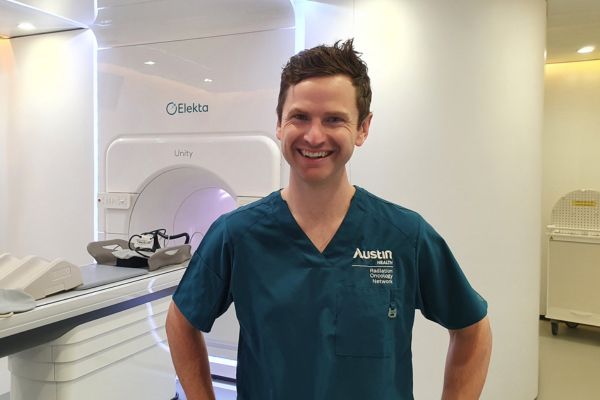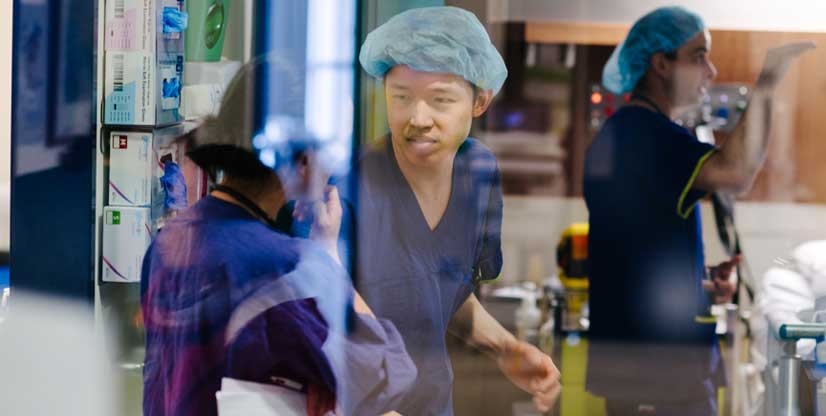About
Staff Spotlight: Meet Brayden Geary
- Home
- About
- Latest news
- Staff Spotlight: Meet Brayden Geary

18 January 2024
Meet Brayden, our Charge Radiation Therapist (RT) and one of our in-house experts on the MR-Linac treatment machine.
Brayden was recently invited to speak at a workshop in Thailand, to empower local radiation therapists to enhance patient care. We caught up with him to discuss his experience and find out what motivated him to become a radiation therapist.
Tell us a bit about yourself.
I’m Brayden Geary – a Charge Radiation Therapist (RT) here in the Radiation Oncology Department at Austin Health. I’ve got two young girls at home, who keep me on my toes. When not at work, I love running, riding and working on the veggie patch at home. I am really looking forward to a bumper crop of tomatoes this year after a terrible 2023 harvest.
Can you tell us a bit about your role?
I joined Austin Health in 2020 to help establish and develop the MRI-RT service. It was right as COVID restrictions started to take hold, so it was an interesting start to my time here.
As a Radiation Therapist, I am responsible for acquiring MRI and CT images, creating and optimising radiation treatment plans, and delivering the treatment for patients with a range of diagnoses. The role requires a great deal of technical skill to utilise the amazing technology we have, as well a large amount of patient interaction, given we provide daily treatments for up to 7 weeks for some patients.
What is the MR-Linac machine? How does it tie-in with what you do?
The MR-Linac is an amazing piece of technology that incorporates a high quality magnetic resonance (MR) imaging system and a high energy, x-ray generating linear accelerator (linac). The MR-Linac enables us to visualise disease and adjacent critical healthy anatomy with greater clarity. Unlike conventional treatments that utilise x-ray-based imaging, we can adapt to any changes that we identify on the day of treatment and optimise the plan for patients throughout the treatment journey. It allows us to provide truly individualised adaptive radiation therapy.
Austin Health is the only centre in Victoria with one of these machines and one of only four in Australia. It is very new to the radiation oncology landscape and has a lot of positive development potential for the care of our patients.
It takes a dedicated and highly skilled multi-disciplinary team to deliver the MR-RT service. We work alongside Radiation Oncologists, Radiographers, Medical Physicists, Social Workers, Dieticians, Speech Pathologists and Nurses.
As a Radiation Therapist, I am responsible for acquiring planning images, designing safe and effective plan dosimetry, and delivering the treatment plan. Our role is highly technical, given the complex systems we work with, and the technical requirements of the treatments we deliver. It is also a very patient focused role given we are responsible for their experience along the radiotherapy pathway.
Tell us about your experience travelling and sharing this information with other healthcare workers.
As part of working on innovative and novel technologies, we have a responsibility to share our experience and knowledge. I was recently invited to speak at a workshop in Thailand, to empower local Radiation Therapists to enhance patient care.
The workshop was funded by the IAEA (International Atomic Energy Agency) and it aimed to improve how Image Guided Radiation Therapy (IGRT) is delivered in Thailand. Alongside other experienced RTs from Ireland and Singapore, we promoted discussion around various aspects of IGRT, from practical clinical process solutions to optimising the use of new technologies.
We identified current challenges of the RT’s role and responsibilities across the patient planning and treatment pathway. Alongside some recommendations, we gave an overview of the current role and training of RTs in different regions of the world and highlighted the benefits of increasing knowledge and capacity to influence improved patient care and job satisfaction.
What is something you have learned while travelling that you will bring back to your role at Austin Health?
The technology we use is constantly evolving and changing the way we deliver care. Being at the forefront of these advancements with the MR-Linac, it was really rewarding to share my experience, partner with international colleagues, and work through clinical protocols and processes. Listening to others' experiences with establishing new technologies was also insightful.
Building relationships to foster ongoing support networks makes me feel like I am contributing to the improvement of care and shaping the future not just here at Austin Health but also to the broader international radiation oncology community.


